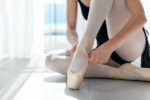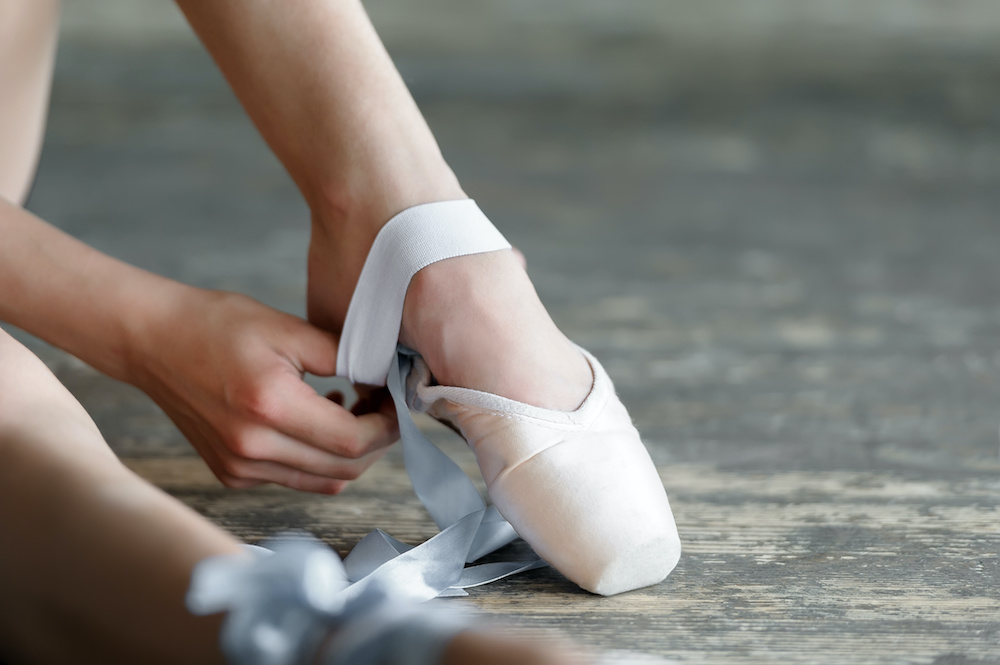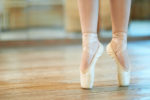How Should Pointe Shoes Fit: Choosing the Right Size

The way that pointe shoes fit is sure to be different from any other shoe you have tried on before.
In fact, finding the right fit can be one of the most complicated parts of learning how to go en pointe.
Before you can even begin to study the art of dancing on pointe, you first have to learn about getting the right fit on your shoes.
Pointe shoes fit uniquely, and there are many parts of the shoe that you need to pay attention to.
Learn more about the fitting process for pointe shoes today.
With this experience, you’ll be more prepared to get the right shoes when you begin shopping for the best pointe shoes.
Do Ballet Shoes Run True To Size?
There are a number of different types of ballet shoes, and they all have their own fitting style.
Ballet shoes of all types, pointe shoes included, do not line up with street sizes.
While some people may have similar sizes in both pairs, there is no way to directly correlate your street shoe size with your ballet shoe size.
Instead, you should focus on finding the right shoe based on the fit of the shoe.
When sizing tiny feet, you can measure your toddler's feet to find the right fit.
How To Fit Pointe Shoes as a Beginner
When trying to find the right pointe shoe fit and learning how should pointe shoes fit, here are two of the most important things to consider:
Be Familiar With the Shoe Parts
When going to your first point shoe fitting, you want to make sure that you are familiar with the shoe parts.
By learning the words below before your fitting, you’ll be better prepared to have a successful fitting.
- Vamp: The front part of the shoe that encloses the box and platform.
- Last: The mold the shoe is made with.
- Platform: The flat top area that you dance on top of when en pointe.
- Paste: Glue used to harden the box, which is available in various strengths.
- Shank: The “backbone” of the shoe that is available in varying degrees of flexibility
- Style: The model of the shoe. Every brand has various styles.
Know What To Bring To Your First Fitting
When attending your first fitting, you want to make sure that you are wearing the right thing.
Make sure that you wear the style of tights that you typically wear.
Additionally, you will want to bring the toe pads that you plan to wear with your shoes.
Both of these things will affect the fit of the shoes.
How Should a Pointe Shoe Fit?
Many brands make pointe shoes, and each company creates a variety of styles and shapes.
Suffolk Pointe shoes for example fit two sizes smaller than typical American made shoes.
That is because people have different types of feet, and there are various uses for pointe shoes.
While this is great once you are more experienced in what you need for your personal shoes, it can be very overwhelming for the first-time buyer.
What should you be looking for specifically in your pointe shoe fit?
The following things should all be done to ensure that you have the right fit:
Check the Box Fit
When standing, your fit should lay flat in the box, and your toes should not be squished into the box.
Additionally, your skin should not be pushed over the top of the box of the shoe.
While the top of the box should touch your skin, you should have enough room to be able to slide your fingertip into the top with a little bit of effort.
If there is too much room at the top of the box, the box is likely too round for your foot.

Check the Wing Length
The wings are the sides of the toe box. Ideally, these will come up the side to reach the big toe’s joint.
Wings that are too short will cause the big toe to be pulled at a strange angle, causing pain.
Wings that are too long will be hard to work in.
Check the Heel Position
The heel’s satin should nearly reach your heel bone.
If it fully covers your heel bone or the satin only covers ½ or less of your heel bone, you will encounter fit-related problems.
Check the Vamp Length
If the vamp is too long, rising en pointe will be difficult to do smoothly.
If the vamp is too short for your toes, the fit will not be comfortable.
Do a Plié in Second
By doing a plié in second, you can check how much room is in the shoe while you're dancing.
Throughout the plié, pay attention to the position of your toes.
They should stay fully elongated throughout the plié and only touch the top of the box at the deepest part of your plié.
If you have very short toes, adding extra padding can help you to improve the fit.
Test En Pointe
While keeping all of your weight on the other foot, place the tip of your shoe on the floor.
Put a slight amount of pressure on the top of the box to check the fit.
Your foot should not sink, and your foot should feel supported.
Keep your foot in this position with a slight amount of pressure.
Then check how much satin there is on the back of your foot.
Baggy heels during this test could mean the shoe is too wide, while your foot popping out of the shoe could mean the box is too small.
Check Shoe Length
Fold the back of the satin of the shoe around the heel and underneath of the shoe.
Then, repeat the test en pointe as outlined above by placing the shoe en pointe and putting a small amount of pressure on the shoe.
The shank, or sole, of the shoe should end just before your heel does.
If it is too long or short, you are likely to experience fit-related issues while dancing.
Full Test
After checking those things to see how good the fit is, you can move on to putting weight on the shoes while testing them.
Holding onto something stable, put one foot fully en pointe, gradually transfer your weight to it, and then rise so that both feet are en pointe.
At this point, you should check the following:
- Are there any points of severe pressure?
- Are your toes still long in the shoe?
- Does anything feel out of place?
While you can fix some issues by using specific padding, you want to get as good of a fit as possible with just the shoe.
How Do You Know When Your Pointe Shoes Are Too Small?
Are you worried that your pointe shoes might be too small?
Pointe shoes that are too big or too small can cause secondary problems for your dancing and feet.
You want to be aware of common signs of your shoes being too small so that you can address them when you get your next pair of pointe shoes.
Here are some common signs that your pointe shoes may be too small; learn about these problems to be more aware:
- Toes do not lay flat in the box
- The sole squeezes the sides of your feet too much
- The sole creases on the sides of the shoe
- Blisters are forming on your feels
- Little toes are heavily pinched
- Pain occurs just from wearing the shoes
Those are some of the most basic signs that your pointe shoes may be too tight.
How Do You Know Which Pointe Shoe Is Right for You?
When choosing between different styles of pointe shoes, you want to consider a few specific factors:
What Is Your Level?
- If you are a complete beginner to pointe shoes, you should make sure to shop according to your teacher’s recommendations.
- Pointe shoes for beginners are often designed specifically with a softer shank to make rolling onto pointe easier.
- Additionally, beginner shoes often have a wider toe box in order to give you a more stable surface when on pointe.
What Are Your Arches Like?
- Those with very high or low arches will need very different pointe shoes.
- Some shanks are longer than others; some are tougher than others.
- As you gain experience on pointe, you’ll have a better idea of how different shanks' styles affect your experience while dancing.
Ultimately, it will be very difficult to get how should pointe shoes fit, and that’s okay.
Pointe Shoes Fit: The Conclusion
Point shoe fitting is incredibly important, but it’s okay if you don’t get the perfect fit right away.
It takes many dancers a year or longer to try different pairs of pointe shoes until they find which brand has the perfect box shape for their feet.
As your dancing and strength change, the shoes that work best for you may change too.
The key is to pay attention to how your shoes are fitting continually.
Look out for common fit problems and make sure to address them as quickly as possible.
If you aren’t sure how to fix the problems you encounter, talk with your teacher or more experienced dancers.
The fit of your pointe shoes is largely about the experience.
Learn the basics of how to fit pointe shoes, and then get out there to start experiencing it for yourself!


